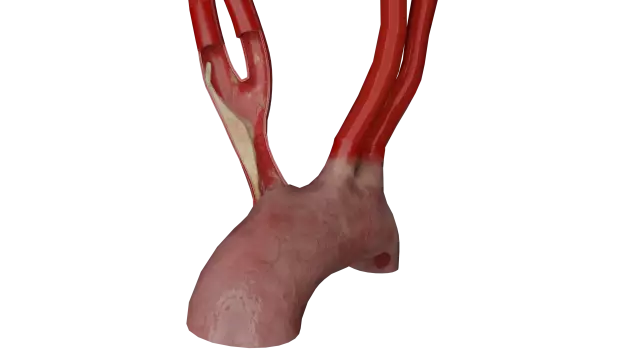- Author Rachel Wainwright [email protected].
- Public 2023-12-15 07:39.
- Last modified 2025-11-02 20:14.
Aortic arch

The aortic arch is a bend of the aorta to the left at the level of the sternum with a transition through the left bronchus.
The structure and location of the aortic arch
The aortic arch passes into the descending aorta with a slight upward bulge and a backward bend. There is a slight narrowing in front of the arch called the aortic isthmus. This isthmus is located between the aortic arch and the descending aorta.
The aortic arch is directed from the second rib cartilage to the left 3-4 thoracic vertebrae. In some cases, the branches of the aortic arch reach the brachiocephalic trunk and the right carotid artery, and there may also be developmental options in which the branches of the aortic arch and two brachiocephalic trunks - right and left - are connected.
The aortic arch is connected to three large vessels - the common carotid artery, the subclavian artery, and the brachiocephalic trunk. The largest vessel 4 cm long is the brachiocephalic trunk. It departs from the aortic arch upward at the level of the sternoclavicular joint and divides into two branches - the right carotid artery and the right subclavian artery. With some features of anatomical development in humans, the lower thyroid artery may branch off from the brachiocephalic vessel.
Congenital deformity of the aortic arch
In some cases of abnormal development of the aortic arch, its congenital tortuosity, which is called deformity, may appear. This developmental anomaly occurs in 0.4-0.6% of patients with cardiovascular diseases and 3% of patients with aortic coarctation.
Congenital tortuosity of the aortic arch is expressed in its lengthening, bending and pathological thinning of the vessel walls. In some cases, the aortic arch is hardened and has symptoms of stenosis (narrowing).
The causes of the deformity have not been identified, but medical studies have shown that this anomaly begins during intrauterine development under the influence of a number of factors and hereditary predisposition.
There are two main types of deformation:
- Congenital deformity with lengthening and bending of the artery;
- Congenital deformity, in which the aortic arch is compacted, and the walls of the vessels are narrowed.
In the future, deformation can develop into several defects:
- A defect with an inflection between the carotid and anonymous arteries;
- Defect with inflection of the left carotid and subclavian arteries;
- Defect with a bend of the aorta at the branching point of the subclavian artery.
In the overwhelming majority of cases, with deformation of the aortic arch, circulatory disorders are not observed, but the load on the vessel walls increases and an aortic aneurysm may form.

With severe deformation of the aortic arch, compression of the esophagus, trachea and nerve trunks can occur. For the treatment of deformity of the aortic arch, a special drug course is prescribed, followed by surgical intervention.
Diseases of the aortic arch
The main diseases of the aortic arch are aneurysm and hypoplasia.
Aortic arch aneurysm is an atherosclerotic or traumatic vascular lesion. Symptoms of an aneurysm of the aortic arch are vascular lesions of the heart and brain, headache, pain in the chest, shortness of breath, severe pulsation in the chest, paresis of the recurrent nerve.
To diagnose aneurysm, X-ray examination and aortography are performed, which allows you to establish the degree of change in the aortic wall. Aneurysm of the aortic arch is treated with the help of surgical prosthetics of the aorta and its branches.
Hypoplasia of the aortic arch is a hypotrophy of the middle elements of the aortic vessels and degenerative changes in the plastic membrane, which lead to a break in the aortic isthmus.
The causes of hypoplasia of the aortic arch are hormonal disorders, congenital pathologies, hereditary predisposition, innervation disorders. Aortic arch hypoplasia can affect other arteries, including the function of the renal artery.
For serious disorders caused by aortic hypoplasia, surgery is performed. After the operation, partial correction of heart defects and other cardiovascular diseases is performed. Then, drug treatment with glycosides and diuretics is prescribed.
Found a mistake in the text? Select it and press Ctrl + Enter.






